
 |
|||||
|
|
|||||
|
|
|
|
||||||||||
|
|
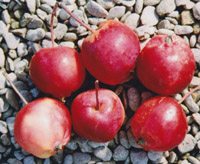 |
PURPLE SIBERIAN CRAB A very old crab from Siberia, long grown in the West, particularly for cider and as a breeding parent for other cider varieties. Striking apples, in full clusters of small apples, coloured richly red and looking rather like large red cherries. The stalk is long, the eye protruding, knobbed and flat with the crown, there being no basin. The flesh is deeply stained with carmine and very sharp. Ripe in early September and not lasting beyond the end of October. Pollination Group 4 |
||
QUATFORD AROMATIC An old Shropshire apple, associated with the village of Quatford, It was first recorded in 1851 but is probably much older. In 1872 Scott described it as: “Small, top quality, December. Very good with a rich aromatic flavour; a very nice little dessert fruit, and keeps sound for a long time”. At the 1885 National Apple Congress, Barron described it as ‘dessert, medium sized, conical angular, flushed yellow russet, brisk, sweet, mid-season’. It has not been known since. We noted that Aromatic Quatford had recently been added to the Grove Heritage Collection in Tasmania and they sent scions in 2013. Our parent tree has not yet fruited but photos and a description from Grove give us confidence that it is the real thing. Pollination Group 5 |
||||
 |
QUEEN
A highly regarded cooking apple, raised by Mr Bull, an Essex farmer, in
1858, from a pip of an apple bought at a local market. It is still widely
grown in Essex. It was first exhibited as The Claimant, later being renamed
Queen. The juicy fruit is large with a yellow skin, beautifully streaked
with scarlet, and cooks to a translucent gold, keeping its shape well,
but softening enough to purée if wanted. The flavour is full. An
excellent pie apple. Crops are good and very regular. A middle season
apple of striking appearance which never disappoints. Part tip bearing,
but also forming enough spurs. The blossom is very attractive. Pollination
Group 3 |
|||
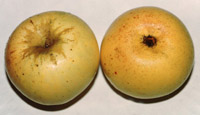 |
QUEEN
CAROLINE Raised around 1820 by Mr T. Brown, who had a nursery
at Measham, near Ashby-de-la-Zouch, in Leicestershire, and named after
the wife of King George IV. It was described by Hogg as 'A cooking apple
of no great merit', but it is better than that. Medium to large sized
fruit, round oblong, with smooth, green-yellow skin, russet flecks and
rays of russet around the stalk cavity. The flesh is tender, and mildly
acid. Though it is sweet, it is too acid to eat raw, with pleasure. It
is in season during October and November. At the National Apple Congress
in 1883 Mr Pownall, of Linton Hall gardens, Nottinghamshire, said it was
known around Birmingham as Brown’s Queen Caroline as ‘it came
into bearing when Queen Caroline’s cause was in the law courts’.
It cooks to a creamy purée which needs a little sugar added to
be very rich and tangy. Attractive pink blossom. Pollination Group 4 |
|||
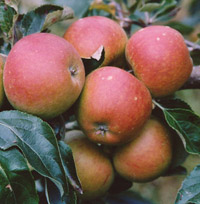 |
QUEEN
COX A sport of Cox’s Orange Pippin, with red flushed skin
and the same firm, richly flavoured flesh. It was discovered at Kingston
Bagpuize, Oxfordshire, in 1953. Like Cox’s Orange Pippin, it needs
care to crop well, disliking wet sites. Pollination Group 3 |
|||
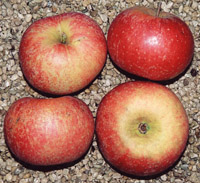 |
RADFORD
BEAUTY Sent to Dr Hogg in 1884 by Pearson and Sons, of Chilwell,
Notts. A stunning medium sized dessert apple with gold skin, blushed and
streaked with red. It has crisp, juicy flesh, with a rich, tangy flavour
Popular in its native Nottinghamshire but also very popular in Cambridgeshire
in the first half of the 20th century. A good middle/late apple, that
stores to December. Dark buds and attractive blossom. Pollination Group
4 |
|||
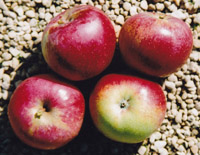 |
RAMBOUR
FRANC The first record of this old apple is in 1535 and it has
acquired over 130 synonyms during its life. It is said to have come from
Rambure, near Abbeville, France, though Hogg says Rembures, Picardy. It
was widely grown throughout Europe and has long been grown in Britain
– Ray mentions it in 1665 – but it appears to have vanished
from cultivation here. It was popular in Kent and the West Country. Taylor
says in 1946 that it was still grown in Herefordshire. It has been said
to be a large, flattish, ribbed and irregular fruit with pale yellow skin
and a few red stripes and flushes on the sunny side, with some russet
round the stalk, though other early writers point to it being more fully
red. Here it is a richly red, attractive fruit and fairly uniformly round.
The flesh is firm with slightly acid juice but sweet with a good flavour
when eaten fresh. It actually keeps well into the New Year, with a rich,
complex flavour and perfumed taste. The flesh is a bit chewy but it stays
moist. It doesn't respond fully to cooking in a pan, not breaking down
and losing some flavour. The strong trees bear good crops. Scions were
sent to us from the U.S. Plant Genetic Resources Unit at Cornell University,
and new trees were grafted in 2005. Pollination Group 5 |
|||
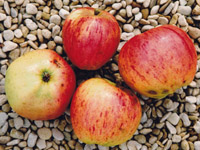 |
RANK
THORN 1 Sent to us by Hilary Wilson, of Appleby in Westmorland,
conservationist and hunter of historic fruit trees, who came across this,
the last known old tree in its native Westmorland (Cumbria). The tree
was owned (it has now died) by Mr Desmond Holmes of the Lyth Valley. The
Holmes family settled at Whitebeck in 1747 and sold fruit to market until
the 1960s. It was received by the National Fruit Trials in 1951 but is
19th century or much earlier. It was named after the old wood in which
it was originally found, growing wild. There was a Rank Thorne, exhibited
from Cumberland in 1934 that appears to be a different, late apple, but
might simply reflect modern observations that in some years it is ripe
late and will store for some time, especially in the north. Rank Thorn
is a large, conical, ribbed apple with pale yellow skin, flushed (often
heavily) dull red and pink and with bright red streaks. Though always
considered a mid-season dessert apple, it is also a first class cooking
apple. When first ripe in September, it has firm juicy flesh, soon softening,
with a pleasant sweet flavour but when cooked it keeps its shape and has
the richest, sweetest and most fragrant flavour. It can be used for cooking
up to the end of the year, in the south. It fruits when young - regularly
and abundantly. Pollination Group 5 |
|||
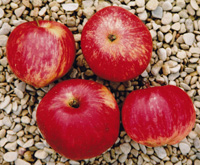 |
RANK
THORN 2 The ‘Rank Thorn’ that was sent to the National
Collection in 1951 is different, but not sufficiently different to suspect
anything other than mutation either before or after it entered the National
Collection. It is like the above version from Westmorland in all respects
other than colour and flavour. We have grown both, side by side, on the
same rootstock for several years. Rank Thorn 2 is more brightly coloured
and more boldly striped, making it a very showy apple. Possibly the flesh
is a shade paler. Equally good for dessert but, when cooked, this version
is a little flatter in flavour and slightly watery. An interesting example
of how the same apple can ‘drift’ in its nature, over time.
Pollination Group 5 |
|||
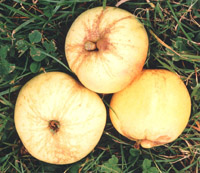 |
RATHE
RIPE All the earliest references have named this apple ‘Rather
Ripe’ and we have recently suggested that this should be the correct
and more logical name. Further enquiry by us suggests our assumption is
wrong. John Evelyn’s 1691 translation of ‘The French Gardiner…’
(from Nicolas de Bonnefons ‘Le Jardinier Francois’ 1651) includes
‘A Catalogue of the Names of Fruits Known about Paris’. Evelyn
titles those that do not keep as ‘Rath-ripe Apples’. Elsewhere
he calls early fruits ‘Rathe ripe.’ He is not referring to
a particular variety as being called this. A good dictionary tells us
that ‘Rath or Rathe’ come from old English, meaning quick,
hasty, coming before others, ‘esp. of flowers, early blooming, of
fruits, early ripening’. “Bring the rathe primrose that forsaken
dies” Milton, or Tennyson “The men of rathe or riper years”.
We revise our judgement and despite earliest references of this particular
apple having been called Rather Ripe, the origin seems to have been Rathe
Ripe. As Rather Ripe, this apple first appeared in the London Horticultural
Society catalogue of 1826 and then in the 1831 and 1842 editions. Scott
noted it in his supplemental list in ‘The Orchardist’ in 1872,
and it was exhibited from Surrey at the 1934 Apple and Pear conference
suggesting, along with its LHS provenance, that it is a Home Counties
apple. A small dessert apple, oblate to conic and early season, ripe in
August/September. The body is ribbed up to the eye, pale green to lemon
yellow, with an occasional orange flush and netted russet. The flesh is
a little soft and dryish but with a sweet flavour. Attractive dark flower
buds. Pollination Group 3 |
|||
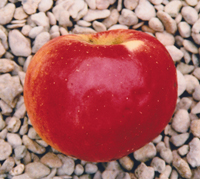 |
RED
ARMY Another of the many apples bred by F.W. Wastie of Eynsham,
Oxfordshire, raised in 1924, and first recorded when his son, J.F. Wastie,
(who named the apple) sent it to RHS Wisley in 1943. It was bred from
a cross of Chatley’s Kernel and Worcester Pearmain. Apple names
like Comrade Wastie and Red Army might suggest political leanings to the
left, but correspondence shown to us by Jack Wastie suggests the opposite,
and perhaps the namings were in appreciation of a wartime ally. Medium
sized with skin of pale yellow, flushed and striped with red. The flesh
is crisp, sweet and subacid. Ripe in September, the apples will keep for
a month or two. Showy pink flowers. Pollination Group 3 |
|||
|
||||